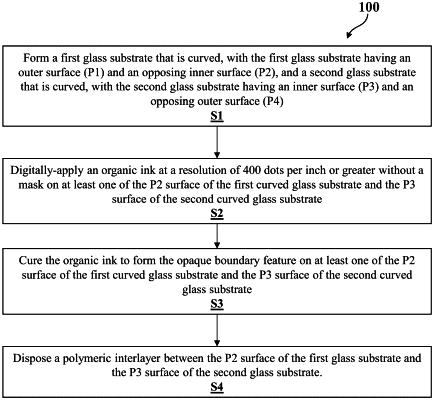| CPC B32B 17/10266 (2013.01) [B32B 17/10036 (2013.01); B32B 17/10293 (2013.01); B32B 17/10348 (2013.01); B32B 17/10935 (2013.01); B32B 37/24 (2013.01); B32B 38/145 (2013.01); C03C 17/001 (2013.01); C03C 17/32 (2013.01); C03C 17/42 (2013.01); B32B 2037/243 (2013.01); B32B 2250/03 (2013.01); B32B 2255/20 (2013.01); B32B 2255/26 (2013.01); B32B 2255/28 (2013.01); B32B 2307/41 (2013.01); B32B 2307/412 (2013.01); B32B 2310/0831 (2013.01); B32B 2315/08 (2013.01); B32B 2605/006 (2013.01); B32B 2605/08 (2013.01); C03C 2218/119 (2013.01); C03C 2218/32 (2013.01)] | 27 Claims |

|
1. A method of manufacturing a glass assembly to have an opaque boundary feature, said method comprising:
forming a first glass substrate that is curved, with the first glass substrate having an outer surface (P1) and an opposing inner surface (P2), and a second glass substrate that is curved, with the second glass substrate having an inner surface (P3) and an opposing outer surface (P4);
digitally-applying an organic ink without a mask on at least one of the P2 surface of the first curved glass substrate and the P3 surface of the second curved glass substrate;
curing the organic ink to form the opaque boundary feature on at least one of the P2 surface of the first curved glass substrate and the P3 surface of the second curved glass substrate, wherein the opaque boundary feature has a resolution of greater than 200 dots per inch; and
disposing a polymeric interlayer between the P2 surface of the first glass substrate and the P3 surface of the second glass substrate.
|